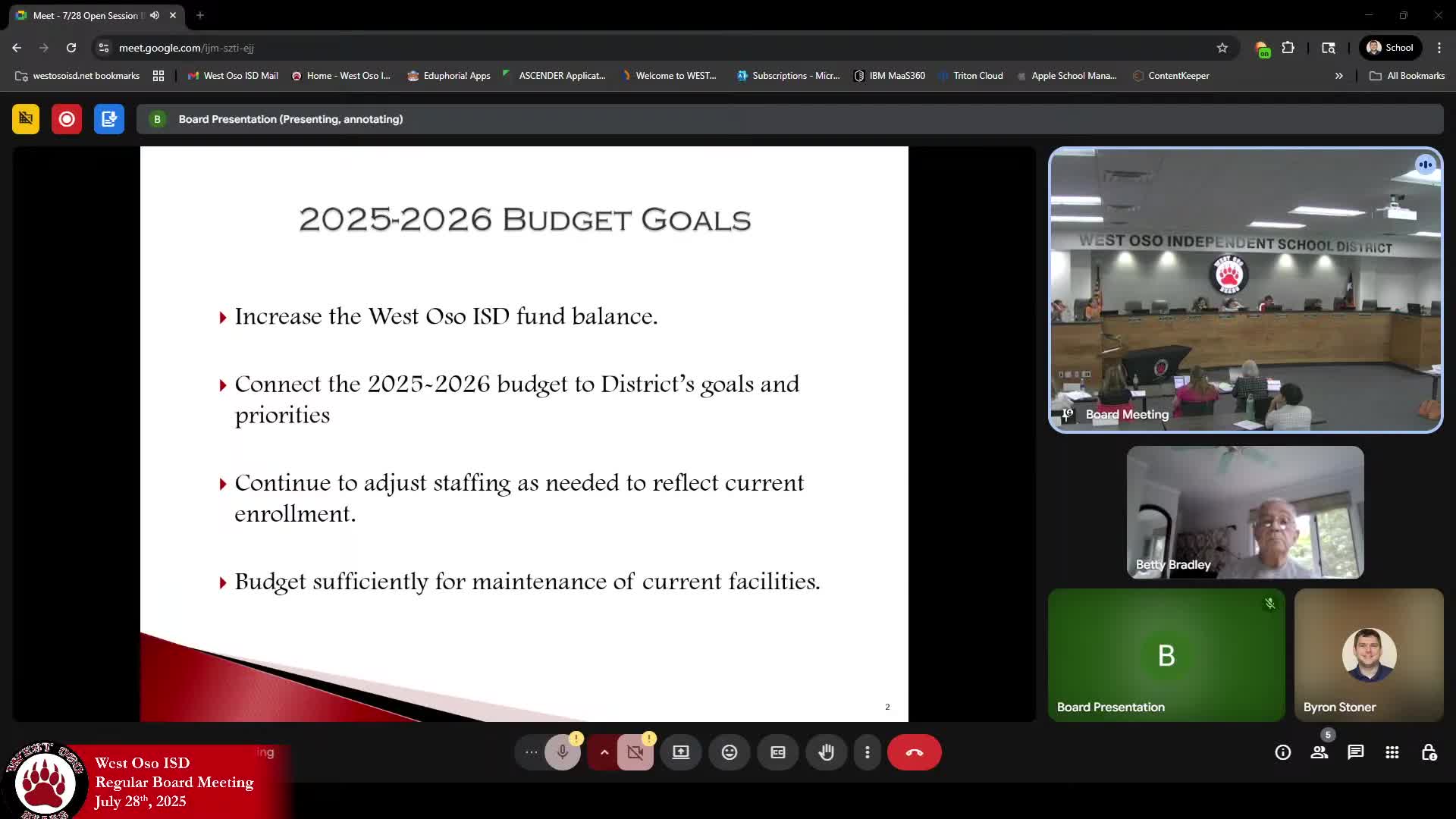School Board Discusses 2024 Budget Strategies Amid Declining Enrollment Concerns
July 31, 2025 | WEST OSO ISD, School Districts, Texas
This article was created by AI summarizing key points discussed. AI makes mistakes, so for full details and context, please refer to the video of the full meeting. Please report any errors so we can fix them. Report an error »

In a recent board meeting held on July 28, 2025, Texas school officials gathered to discuss pressing budgetary concerns and the impact of declining enrollment on district funding. The atmosphere was charged with urgency as administrators outlined the challenges they face in maintaining financial stability amid fluctuating student numbers.
The meeting opened with a focus on the 2025-2026 budget goals, where officials expressed a commitment to preserving the district's fund balance. However, they acknowledged that the current trend of declining enrollment poses a significant threat to their financial planning. "Enrollment is declining, so we have to really make sure that enrollment is tied to our salaries and staffing," one official noted, emphasizing the direct correlation between student numbers and funding.
As discussions progressed, the board highlighted the importance of a modified zero-based budgeting approach, ensuring compliance and transparency in financial operations. They pointed out that state and federal funding remains uncertain, particularly with recent holds on federal allocations. Local property taxes were also under scrutiny, with potential changes in homestead exemptions expected to affect future revenue.
The board's financial projections revealed a stark reality: revenue growth has not kept pace with inflation over the past 18 years. "We're looking more at $18 million for the upcoming year, which is less than a 12% increase," an official stated, illustrating the financial strain the district is under. The conversation shifted to staffing costs, with officials stressing the need for caution in adjusting salary scales, particularly in light of low Average Daily Attendance (ADA) figures.
Enrollment trends were a recurring theme, with officials reporting a loss of 116 students over the past few years. They speculated that factors such as community stagnation and competition from charter schools may be contributing to this decline. "The community is just not a community that's growing," one board member remarked, highlighting the challenges of attracting new families to the district.
As the meeting drew to a close, the board discussed proposed salary scales for teachers and librarians, which included mandated increases from the state. The complexities of funding sources were also addressed, with officials clarifying how federal funding impacts payroll and staffing decisions.
In conclusion, the board meeting underscored the critical intersection of enrollment, funding, and staffing in shaping the future of the district. As officials navigate these challenges, the community watches closely, aware that the decisions made today will resonate for years to come. The board's commitment to transparency and careful planning will be essential as they strive to maintain educational quality in an uncertain financial landscape.
The meeting opened with a focus on the 2025-2026 budget goals, where officials expressed a commitment to preserving the district's fund balance. However, they acknowledged that the current trend of declining enrollment poses a significant threat to their financial planning. "Enrollment is declining, so we have to really make sure that enrollment is tied to our salaries and staffing," one official noted, emphasizing the direct correlation between student numbers and funding.
As discussions progressed, the board highlighted the importance of a modified zero-based budgeting approach, ensuring compliance and transparency in financial operations. They pointed out that state and federal funding remains uncertain, particularly with recent holds on federal allocations. Local property taxes were also under scrutiny, with potential changes in homestead exemptions expected to affect future revenue.
The board's financial projections revealed a stark reality: revenue growth has not kept pace with inflation over the past 18 years. "We're looking more at $18 million for the upcoming year, which is less than a 12% increase," an official stated, illustrating the financial strain the district is under. The conversation shifted to staffing costs, with officials stressing the need for caution in adjusting salary scales, particularly in light of low Average Daily Attendance (ADA) figures.
Enrollment trends were a recurring theme, with officials reporting a loss of 116 students over the past few years. They speculated that factors such as community stagnation and competition from charter schools may be contributing to this decline. "The community is just not a community that's growing," one board member remarked, highlighting the challenges of attracting new families to the district.
As the meeting drew to a close, the board discussed proposed salary scales for teachers and librarians, which included mandated increases from the state. The complexities of funding sources were also addressed, with officials clarifying how federal funding impacts payroll and staffing decisions.
In conclusion, the board meeting underscored the critical intersection of enrollment, funding, and staffing in shaping the future of the district. As officials navigate these challenges, the community watches closely, aware that the decisions made today will resonate for years to come. The board's commitment to transparency and careful planning will be essential as they strive to maintain educational quality in an uncertain financial landscape.
View full meeting
This article is based on a recent meeting—watch the full video and explore the complete transcript for deeper insights into the discussion.
View full meeting
